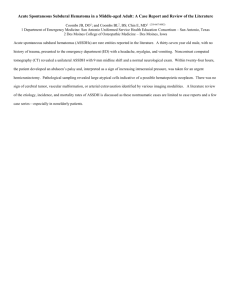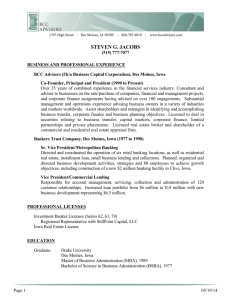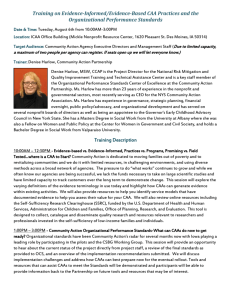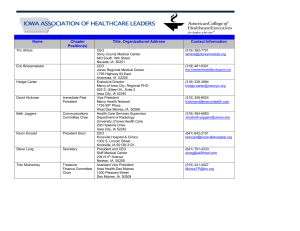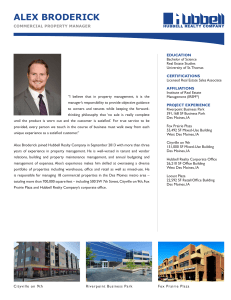The Economic Value of Arts, Cultural, and Heritage Organizations to
advertisement
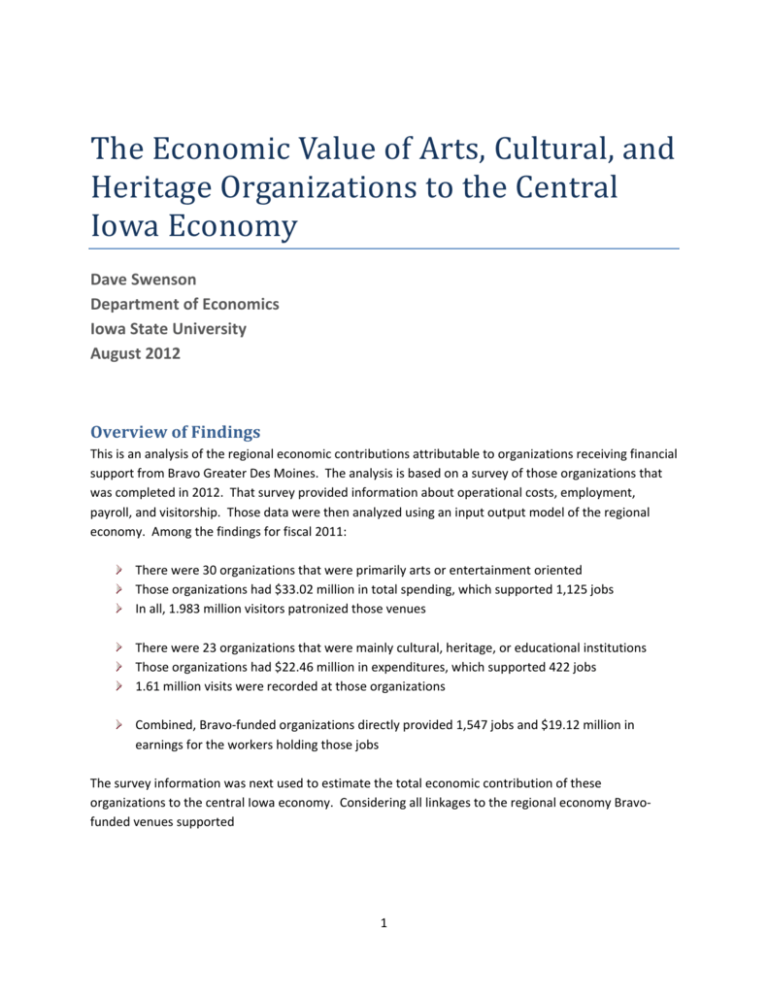
TheEconomicValueofArts,Cultural,and HeritageOrganizationstotheCentral IowaEconomy Dave Swenson Department of Economics Iowa State University August 2012 OverviewofFindings This is an analysis of the regional economic contributions attributable to organizations receiving financial support from Bravo Greater Des Moines. The analysis is based on a survey of those organizations that was completed in 2012. That survey provided information about operational costs, employment, payroll, and visitorship. Those data were then analyzed using an input output model of the regional economy. Among the findings for fiscal 2011: There were 30 organizations that were primarily arts or entertainment oriented Those organizations had $33.02 million in total spending, which supported 1,125 jobs In all, 1.983 million visitors patronized those venues There were 23 organizations that were mainly cultural, heritage, or educational institutions Those organizations had $22.46 million in expenditures, which supported 422 jobs 1.61 million visits were recorded at those organizations Combined, Bravo‐funded organizations directly provided 1,547 jobs and $19.12 million in earnings for the workers holding those jobs The survey information was next used to estimate the total economic contribution of these organizations to the central Iowa economy. Considering all linkages to the regional economy Bravo‐ funded venues supported 1 2,144 total jobs regionally earning $41.26 million in labor income In so doing, they supported a total industrial output amounting to $114.14 million which yielded $57.2 million in value added (the equivalent of GDP) Lastly, expected fiscal contributions were calculated: total labor income supported by Bravo‐ funded projects generated an estimated $6.64 million in own‐source revenues for state and local governments All of these organizations are sources of artistic, cultural, and educational enrichment, and they have value as intrinsic and important components of the regional economy. These organizations produce services that employ and pay workers, require inputs from regional businesses, and are consumed by households, schools, and other regional and statewide institutions that serve Iowa. These institutions are also strong components of the collective quality of life to be enjoyed in the region. It is widely recognized that an important component to regional livability includes access to an array of artistic, entertainment, and cultural opportunities. Vibrant modern urban economies have strong cultural, artistic, and entertainment foundations. This study measures their economic value to the region. Their total worth to the region and to the state is much greater and, in large part, immeasurable. Introduction This study estimates the regional economic value of the many regional organizations supported by Bravo Greater Des Moines (hereafter Bravo) in the Des Moines / West Des Moines Metropolitan Statistical Area comprised of Dallas, Guthrie, Madison, Polk, and Warren County.1 The values are estimated using an input‐output model of the regional economy, which estimates the value of activity in the funded organizations along with all associated linkages those organizations have with the remainder of the central Iowa economy. This evaluation looked at 53 entities which are or recently have been supported by Bravo resources and which completed a survey allowing for an itemization of their overall financial operations for the purposes of this evaluation. This evaluation is provided as a for‐fee service of Iowa State University in support of regional economic development and community economic education. 1 Guthrie and Madison County were added to the Des Moines MSA county list after the 2000 census. West Des Moines attained a core population in excess of 50,000 in 2002, according to U.S. Census estimates. Soon thereafter the region was classified as the Des Moines / West Des Moines Metropolitan Statistical Area. New MSA definitions are due in 2013, which might increase the number of counties in this MSA. 2 Table 1 lists the surveyed organizations. They are divided into those primarily providing artistic or entertainment services to the community, of which there were 30, and the 23 providing cultural, heritage, or educational services to the region. This classification has a functional purpose as it allows for summing the characteristics in alignment with the industrial classifications that are contained within the modeling system used for this study. Subsequent tables will describe the overall contributions of each subdivision to the regional economy as well as combined values to determine the overall economic effects of these regional assets. Table 1 Area Organizations Surveyed for This Analysis Primarily Arts & Entertainment Primarily Cultural, Heritage, or Educational After School Arts Program Blank Park Zoo Ballet Des Moines City of WDM Parks & Rec City of Clive Public Arts Commission City of Windsor Heights Civic Center of Greater Des Moines Clive Historical Society Civic Music Association Culture All Des Moines Art Center Des Moines Community Radio Foundation Des Moines Arts Festival Fort Des Moines Museum Des Moines Choral Society Greater Des Moines Botanical Garden Des Moines Community Orchestra Historic Valley Junction Des Moines Community Playhouse I'll Make Me a World in Iowa Des Moines Diversity Chorus Iowa Asian Alliance Des Moines Gay Men's Chorus Iowa Gold Star Military Museum Des Moines Metro Opera Iowa Hall of Pride Des Moines Social Club Iowa Irish, Inc. Des Moines Symphony Italian‐American Cultural Center Des Moines Vocal Arts Ensemble Latino Resources Downtown Events Group Living History Farms Gateway Dance Theatre Salisbury House Foundation Greater Des Moines Music Coalition Science Center of Iowa Greater Des Moines Public Art Foundation State Historical Museum of Iowa Heartland Youth Choir Urbandale Historical Society Hoyt Sherman Place West Des Moines Historical Society Iowa Shakespeare Experience World Food Prize Iowa Youth Chorus Metro Arts Alliance Music Under the Stars Repertory Theatre of Iowa Stage West Theatre Company Tall Grass Theatre Company Waukee Area Arts Council 3 Though we value these organizations as the sources of artistic, cultural, and educational enrichment, they all have value as intrinsic and important components of the regional economy. These organizations produce services that employ and pay workers, require inputs from regional businesses, and are consumed by households, schools, and other regional and statewide institutions that serve Iowa. These institutions are also strong components of the collective quality of life to be enjoyed in the region. It is widely recognized that an important component to regional livability includes access to an array of artistic, entertainment, and cultural opportunities. Vibrant modern urban economies have strong cultural, artistic, and entertainment foundations.2 CompilingtheDirectValues This study uses a current input output model of the regional economy. The “inputs” into that model are the overall annual operational characteristics of the organizations that were surveyed. Table 2 contains those values. In all, the arts and entertainment organizations had $34.71 million in total revenue and $33.02 million in total expenditures in Fiscal 2011; the cultural and educational organizations had$22.36 million in total revenue and $22.46 million in expenditures. The arts and entertainment group paid 1,125 job holders of all types $9.51 million in labor incomes, while the cultural and educational group paid 422 job holders $9.61 million in labor incomes. These are among the primary direct inputs used to model the value of these organizations to the regional economy. For informational purposes only, not for modeling purposes, the table also lists the total volunteers and an estimate of the total volunteer value to those organizations. Each volunteer was assumed to contribute 33 hours priced at the minimum wage3. The value of those efforts was $1.54 million for the arts and entertainment group and $1.37 million for the cultural and educational group. 4 2 The most notable recent argument for the importance of nurturing creative activities is found in Florida, Richard, The Rise of The Creative Class (Basic Books, 2002). He talks about the importance of a wide array of creative activities when profiling modern economic growth, not just the artistic or cultural subset of that total. Many, however, narrowly reduce his treatise as one arguing that the arts create the conditions for broader economic growth. Florida’s work in fact concludes there is a very strong coincidence of many creative groupings to include the necessary talents of scientists, educators, professionals, as well as artists or performers in healthy and dynamic metropolitan economies. 3 In the 2007 study of Bravo‐funded organizations, the number of hours donated was a separate survey question. There, however, is no systematic accounting of volunteer hours to gauge the reliability of those responses, and that question was not asked in this survey. The 2007 survey estimated average hours per volunteer as 46. I now judge that number as high. A reduction to 33 hours seemed prudent, if not still generous, for this assessment. That 2007 survey also counted directors’ and other unpaid officers’ volunteer hours. While it may rankle some to have that effort priced at minimum wage, it is important to note that the average job for the entire group of organizations, as measured in Table 2, pays, were the job evaluated on an annual basis, less than the minimum wage. 4 Earlier studies by this analyst added volunteer values to the total output value. That addition imputed a higher amount for output for reporting purposes; however, the actual modeling was done excluding the volunteer contributions. While volunteer contributions in fact represent “value” to the recipients, those values are not recorded in a manner that allows entry into a modeling system. They can be used, for example, as match for 4 Table 2 Income All Contributions Other Income Total Income Selected Direct Economic Values Arts and Cultural and Entertainment Educational Total 11,562,796 23,146,941 $ 34,709,737 9,731,780 12,623,872 $ 22,355,652 21,294,576 35,770,813 $ 57,065,389 Expenses Personnel Expenses Other Expenses Total Expenses 9,512,340 23,504,806 $ 33,017,146 9,609,375 12,850,820 $ 22,460,195 19,121,715 36,355,626 $ 55,477,341 Employment Full Time Part‐Time, Temp., or Seasonal Total Jobs 140 985 1,125 171 251 422 311 1,236 1,547 6,431 5,725 12,156 $ 1,538,617 $ 1,369,615 $ 2,908,232 Volunteers Imputed value of volunteer contributions (see footnotes 3 and 4) The next component of the economic analysis involves visitorship. According to the survey results, an estimated 3.6 million people from central Iowa and beyond visited these venues in fiscal 2011.5 Visitorship has an important role to play when calculating regional economic values. While local residents would be expected to patronize local arts, entertainment, or cultural facilities, visitors from outside of the region can be considered otherwise indifferent as to where they seek and obtain these services. Accordingly, those visitors have a discernible impact on the regional economy when they choose to patronize arts and cultural facilities in the Des Moines area. They represent service exports, i.e., sales to non‐local persons, and the additional spending they make on travel, lodging, and other necessities is added to the impact estimates. grants in some instances, but the value of the assistance is not reflected as an actual quantifiable boost to organizational output. Accordingly, the inclusion of the value of volunteering is an informational exhibit here only. 5 A few improbable visitor values were either thrown out or adjusted downward. 5 Table 3 Total Attendance Greater Des Moines Area Other Iowa Other U.S. Other Countries Estimated Additional Regional Spending by Non‐local Visitors Overall Visitors, 2011 Arts and Entertainment 1,983,311 1,651,763 217,278 109,950 4,320 $ 5,328,589 Cultural and Educational 1,609,031 1,184,814 346,677 73,655 3,885 Total 3,592,342 2,836,577 563,955 183,605 8,205 $ 6,817,951 $12,146,540 Table 3 also provides the estimate of boosted visitor spending attributable to these institutions. For fiscal 2011, the value is $12.15 million. That value was arrived at by using historical surveys and analyses of spending in the Des Moines region.6 For each visitor, spending was allocated across dining, miscellaneous retail, and transportation costs. The probability of an overnight stay is also addressed where 75 percent of all other U.S. and other country visitors are assumed to require lodging in the region, but only 25 percent of other Iowa visitors. Finally, the institutions were scored as to whether they would be expected to be the primary reason for the visit to the region or part of a bundle of activities associated with the visit. The sum of those values and weights produced the expected increment to spending, which also are included in the economic modeling. ComputingtheTotalEconomicValues Input‐output models (IO) are detailed compilations of a region’s industrial structure, and they are used to evaluate the size of an industry or a group of industries and the value of those industries to a regional economy considering all regional inter‐industrial transactions. The IO model for this analysis is made up of all of the industries and institutions contained within the five‐county Des Moines / West Des Moines MSA. There are four kinds of economic values that are reported out of the modeling exercise: Industrial output: This is the value of what is produced by industries as measured on an annual basis. For many firms, it is analogous to gross sales. Value added: This represents payments to workers, to proprietors, to investors, and the indirect taxes that are part of production. Value added is analogous to gross regional product (GDP). Labor income: This is a subset of value added. It includes all wages, salaries, and benefits that are paid to workers and proprietors. 6 The visitor spending values reflect my own research, and they are significantly lower than values that are assumed by local tourism officials or by state surveys. It is important to note that my values also include a probability that the visit is the primary reason for a visit or a secondary reason; hence, the visitor values are adjusted downward to reflect that probability. 6 Jobs. These are the actual number of full‐time and part‐time positions in industries, not the number of employed persons. Many employed persons have more than one job; hence, there are always more jobs in an economy than employed persons. These economic values are reported by four levels: Direct values: These are the values that are attributed to the firm or firms that are being assessed. Indirect values: All of the firms that are assessed require inputs from the regional economy. The degree to which the direct firms link to regional suppliers constitutes the indirect values. Induced values: When the workers in the direct firms and the workers in the supplying (indirect) industries convert their paychecks to household spending, they induce more economic activity in the region to meet household needs. Total values: The sum of direct, indirect, and induced values equals the total value or economic effect of an industry or group of industries to the region. Table 4 presents the modeled results of the arts and entertainment sub‐set of the survey. Those institutions had an estimated $33.02 million in output in 2011, which required 1,125 jobs making $9.51 million in labor income. Those Bravo‐supported institutions required $13.77 million in regionally‐supplied inputs, which in turn supported an additional 145 jobs making $5.95 million in labor income. When the direct and the indirect workers converted their labor incomes into household spending, they induced $14.2 million in additional output in the region, which in turn required 128 jobs making $4.87 million in labor income. Summed, then, the arts and entertainment group accounted for $59.93 million in regional economic total output, $28.27 million in total value added (or GDP), $20.34 million in labor income, and 1,389 jobs. Table 4 Arts and Entertainment Total Economic Values Total output $ Value added $ Labor income $ Jobs Direct + Indirect + Induced = Total Total Multiplier 33,017,146 13,765,608 13,150,576 59,933,329 1.82 11,204,931 8,667,232 8,402,575 28,274,738 2.52 9,512,340 5,949,360 4,874,833 20,336,532 2.14 1,125 145 119 1,389 1.23 There is also a column of multipliers with the table. The total multiplier represents the total change in regional output relative to a unit change in the direct value – it is, therefore, the total value divided by the direct value. Thus, an output multiplier of 1.82 means that for every dollar of output 7 in the direct industries, the arts and entertainment institutions, there is $.82 in output supported in the rest of the economy. The value added multiplier of 2.52 means that for every $1 of value added in these institutions, another $1.52 in value added is realized in the rest of the economy. The labor income multiplier of 2.14 means that for every dollar of labor income in the direct organizations, there is $1.14 in labor income supported in the rest of the economy. Finally, the jobs multiplier of 1.23 means that for every direct job, 23/100th of a job is supported elsewhere in the regional economy. Readers are cautioned to not over‐ infer from the comparatively high value added and labor income multipliers: they are high because the direct values are low for this group of organizations. Stated bluntly, the average pay per job is very low in these industries, most if not all are tax exempt and do not generate indirect tax contributions to value added, and most generate very slim operating surpluses if at all; hence, value added is comparatively small relative to other service industries. Table 5 contains the very same type of estimates for the cultural, heritage, and educational organizations. Looking only at the total values, those entities supported $41.3 million in regional industrial output, $21.92 million of value added (or GDP), $16.62 million in total labor income, and 591 jobs. The value added multiplier, like the previous example, is high owing to all of the characteristics itemized above, but the labor income multiplier is somewhat lower as the average pay in these industries per job is greater than in the preceding example. Table 5 Cultural, Heritage, and Education Total Economic Values Total output $ Value added $ Labor income $ Jobs Direct + Indirect + Induced = Total Total Multiplier 22,460,195 8,302,703 10,530,365 41,293,263 1.84 9,504,833 5,691,099 6,725,408 21,921,339 2.31 9,609,375 3,096,059 3,916,071 16,621,505 1.73 422 74 95 591 1.40 Table 6 presents the combined results. Overall, Bravo‐funded Des Moines area organizations accounted for $101.23 million in regional economic output, supported $50.2 million in value added, and explained $36.96 million in area labor income to 1,980 jobs in 2011. 8 Table 6 Combined Bravo Supported Programs Total Economic Values Total output $ Value added $ Labor income $ Jobs Total Total Multiplier Direct + Indirect + Induced = 55,477,341 22,068,311 23,680,941 101,226,593 1.82 20,709,764 14,358,331 15,127,982 50,196,077 2.42 19,121,715 9,045,419 8,790,904 36,958,038 1.93 1,547 219 213 1,980 1.28 The next table (Table 7) presents the regional economic impacts of visitorship. Readers will remember that out‐of‐region visitors were estimated to have spent $12.15 million in retail purchases, transport, dining and drinking, and for lodging coincident with their visits. Spending was allocated for retail, transport related, dining and drinking, and lodging. When those values were entered into the modeling system, they resulted in $7.65 million in direct regional output requiring 119 jobs making $2.28 million in labor incomes. When all rounds of economic activity worked their way through the economy, visitor spending supported $12.91 million in total regional output, $6.97 million in value added, $4.3 million in labor income, and 164 jobs. Table 7 Visitorship Economic Impacts Total output $ Value added $ Labor income $ Jobs Direct + 7,649,891 3,631,123 2,276,165 119 Indirect + Induced = Total Total Multiplier 2,538,123 2,726,759 12,914,736 1.69 1,597,270 1,741,541 6,969,928 1.92 1,008,375 1,013,823 4,298,357 1.89 21 164 1.38 25 Readers will notice that the direct output value of $7.65 million is much less than the estimated $12.15 million in sales. When modeling visitor spending, total spending on retail goods (gasoline, general merchandise, etc.) is not entered into the model. The portion that represents the cost of the good that is sold, to include all in‐transport costs, is first excluded as it is not counted as a component of retailers’ output; however, all other retail costs (inputs, labor, O&M, etc.) are counted as output. Finally, Table 8 summarizes the Bravo‐funded organization total values with the visitor values. In all, $114.14 million in regional output, $57.17 million in value added, $41.26 million in labor income, and 2,144 jobs are supported. 9 Table 8 Total Regional Economic Activity Supported by Bravo‐Funded Activities Total regional output $ Total value added $ Total labor income $ Total jobs Bravo‐Funded Organizations 101,226,593 50,196,077 36,958,038 1,980 Visitor Effects 12,914,736 6,969,928 4,298,357 164 Total Economic Effects 114,141,329 57,166,005 41,256,395 2,144 ConclusionsandContext The artistic, entertainment, cultural, heritage, and educational institutions receiving assistance from Bravo make important contributions to the regional economy. They directly or indirectly support 2,144 jobs and $41.26 million in labor income. The combined regional economy is, however, very large. In 2011, there were 405,400 jobs in the region, and total personal income was $24.5 billion. Readers may notice that the phrase “economic impact” was only used when describing the visitorship outcomes. The vast majority of the activities studied provide services and enrichment opportunities to regional residents primarily – more than three‐quarters of patronage is local. As such, these venues serve a regional market overwhelmingly. The fractions that serve non‐local markets – patronage by non‐residents, for example – constitute export sales and, therefore, an increment to regional economic activity based on service exports. The total economic value of the organizations to the regional economy is contained in Table 8. Nearly 21 percent of visitors were from out of the region. It is appropriate, then, to apportion 21 percent of the values reported in Table 6 plus all of the values in Table 7, the visitor effects, as the economic impact values. Combined, just on a jobs basis, 580 of the jobs, about 27 percent of total jobs supported, are supported by non‐local patronage. The remaining 73 percent of jobs exist to serve regional demands. Modern urban economies require a wide array of economic, social, cultural, artistic, and natural amenities to sustain population levels and support growth. It is increasingly the case that a region’s artistic and cultural foundations are important quality of life elements in the bundle of amenities that urban settlers value. While this study quantifies the economic value of these amenities using conventional measures, their overall worth to society is wholly intangible: it simply cannot be priced in the market. 10 Appendix:StateandLocalFiscalImpacts All employment contributes to government accounts. Workers pay state and local taxes, fees, and charges. Those contributions, in turn, pay for the government services that workers and their families rely on. As reported in Table 8, all Bravo‐funded organizations ultimately supported $41.26 million in labor incomes in 2011. Those labor incomes, in turn, supported own‐source revenues for state and local governments. The accompanying table provides those estimates. State revenue support amounted to $2.73 million in taxes coupled with $945,949 in charges and fees for a total of $3.67 million. All local government tax collections were $1.92 million plus $1.043 million in charges for a total of $2.96 million. Combined state and local own‐source receipts were $6.64 million. State and Local Government Own Source Revenues Generated from the Total Labor Income Effects State Government All Local Governments 2,728,641 1,916,957 Income Taxes 1,159,240 37,016 Sales Taxes 1,278,236 310,799 All Taxes Property Taxes ‐ 1,541,580 All Other Taxes 291,166 27,562 Charges and Fees 945,949 1,043,512 $ 3,674,591 $ 2,960,469 Total Own Source Revenues 11
